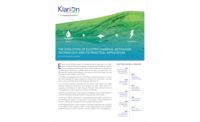Linde LLC offers a new food industry white paper explaining the use and advantages of advanced mixer chilling systems that can help food processors chill products with improved food safety, high efficiency and repeatability while reducing costs.
Titled, “Bottoms up: How better mixer chilling can improve your food process,” the 12-page white paper provides a comprehensive summary of cryogenic bottom-injection (BI) mixer chilling technology, as well as the benefits of advanced systems and how they can be integrated into food processing operations. It can be downloaded from this link.
Cryogenic BI chilling systems achieve high efficiency with a controlled injection of liquid nitrogen (LIN) or carbon dioxide (CO2) from the bottom of mixers, blenders, cookers or kettles. Advanced BI systems, which deliver more accurate temperature control, are tailored to the process. They can be retrofitted to existing equipment and can enhance production of a growing variety of products including: ground meat, poultry and seafood; prepared foods including meat and bean mixes; as well as dough and baking mixes, liquid foods and pastes, dairy products, and even pet foods.
Hygienic Design and Food Safety
Advanced BI systems feature significant improvements in hygienic design which can contribute to food safety efforts, particularly for high-moisture products such as wet poultry mixes. New advanced cryogenic bottom injectors mount flush with the inside surface of the mixer or blender and are self-sealing. Some injection systems are also available with a dual-cryogen option for greater flexibility in supply and production.
Cryogenic BI chilling systems can eliminate the time, labor and safety issues associated with storing and handling dry ice pellets.
Compared to traditional top-chilling of mixers with CO2, advanced BI chilling systems can deliver faster processing with higher output quality and lower operating costs. More consistent product temperatures, both within and between batches, helps improve release from mixing and forming equipment, and shorter mixer cycle times helps avoid overworking ground products for better texture and package appearance.
Click for a brief overview from Linde about selecting cryogenic chilling systems for food processing.
The Linde food team performs in-plant assessments, conducts trial production runs at the Linde Technology Center, and works with processors to develop optimal process solutions. For more information, visit Linde (www.lindefood.com), or call 800-755-9277.
Linde LLC supports the Global Food Safety Initiative (GFSI) and the advancement of food safety. Linde has a Food Safety Management System in place for all bulk carbon dioxide (CO2) plants and air separation facilities supplying the food & beverage industry in North America. In June 2012, Linde became the first supplier to certify all of its CO2 plants to a benchmarked GFSI scheme, FSSC 22000 (Food Safety System Certification).








